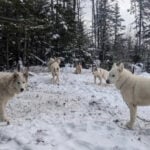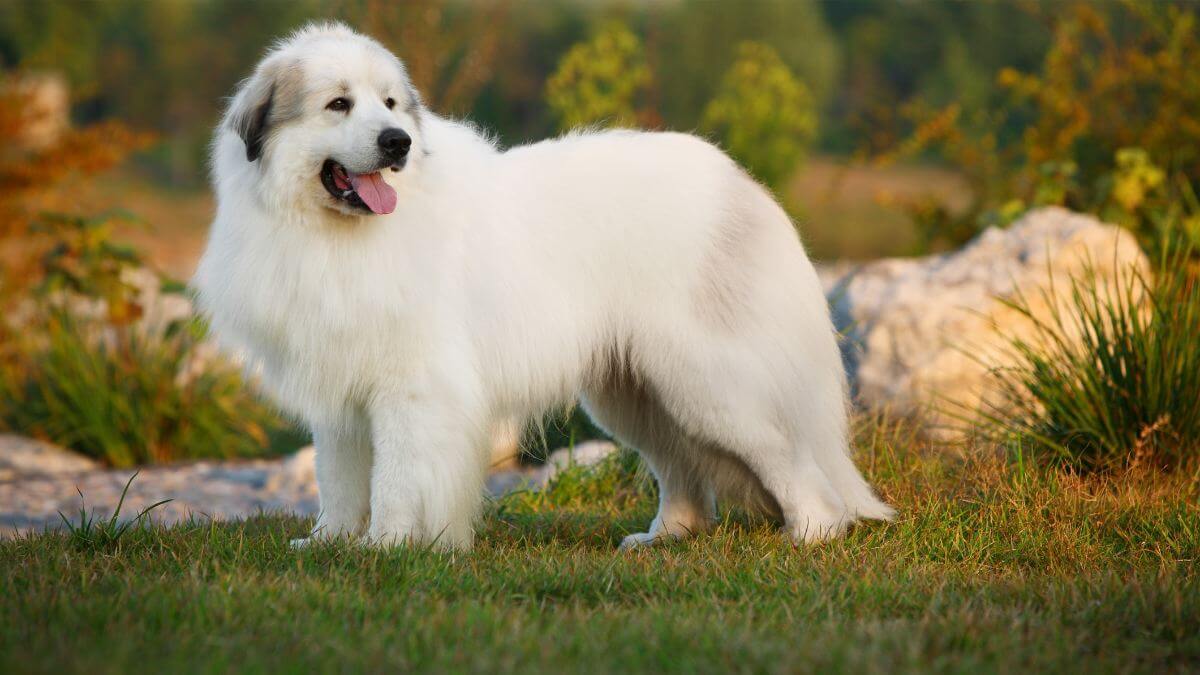


Home » Judging Great Pyrenees

This article was originally published in Showsight Magazine, November 2012 issue.
I am going to present to the reader my thought process and points of greatest concern in judging Great Pyrenees. As with any judging, others may have differing opinions.
When Great Pyrenees walk into your ring, you should be looking for a rectangular dog, only slightly longer than tall. This dog should have a noticeable level, strong back line. He will be white or principally white and can have head markings and/or body coloring up to ⅓ of its body. You will be looking for a large, strong, lithe dog—not one that appears heavy and ponderous or wispy and shelly.
There are three areas of concern in judging the breed: head, front-end assembly, and temperament. I will go through my thought process about each of these important areas in judging the breed.
The Great Pyrenees is a head breed that is hard to understand, as the correct head with “The Look” is seldom seen. “The Look,” as I call it, is the correct melding of pigment, muzzle length, eye color and shape, ear size and placement, and lack of an apparent stop. This occurs, but is rarely seen. You will have the best opportunity to see “The Look” at a national specialty, but even then, it can be elusive.
Approach the Great Pyrenees either straight on or at a three-quarter angle. Cup the head under the jaws and observe the shape of the head. It is wedge-shaped from above and from the side. The bite is a close scissors bite with an even bite being acceptable. Two issues with teeth occur on occasion. In some mature dogs and bitches, the central incisors may appear to recede; this is not an important judging issue.
Now, I put on my veterinary cap. On occasion, in mature dogs (mostly rarely in bitches), you may observe what appears to be lower incisors and even canine teeth that appear worn down so that only “nubbins” appear above the gum line. This condition is called gingival hyperplasia and is actually due to a proliferation of gum (gingival) tissue growth that covers most or all of normal incisor teeth. The upper and lower teeth are aligned normally, but if the condition causes you concern, you should penalize the situation to the point that you feel is warranted. This condition is only factored minimally into my judging of the breed.
At this point, you will become aware of the length of the Pyr’s muzzle. The acceptable length should approximate the length of the back skull and not be less than 40% of the back skull. There are specimens shown with extremely short muzzles—they are cute, like teddy bears, but incorrect. This is not enough muzzle length to aid in doing battle with a predator. The correct muzzle length helps to ensure that the head will have tight, black-pigmented lips. This should not be a drooling breed.
Breed pigmentation is black, beginning with the nose, lips, and eye rims. On occasion, in all-white Pyrs, the nose pigment may fade in the wintertime—snow nose. The only penalty is whether the condition detracts from “The Look” that the dog portrays. To me, there is usually some detraction. Occasionally, Dudley noses are seen with distinct pink and black areas present. Dudley noses can also be associated with incomplete pigmented eye rims.
The eye color of Great Pyrenees is dark brown, and the eyelid shape is almond. The eye color can range from almost yellow to almost black. The color that you accept in judging is the one that compliments “The Look.” In Pyrs that have short muzzles and/or too much stop, there is a tendency for round eyes and increased tear stain on the white hair at the inner corner of the eyes.
The Great Pyrenees ear is small to medium in size and set on at the level of the outer corner of the eyelid. A line of hair can be followed from the outer corner of the eye to the root of the ear set. If the ear set is too high, the line does not meet the root of the ear. Ears set too high or are too large detract from “The Look.” In rare instances, low-set, houndy ears may be found.
The most difficult concept pertaining to the Great Pyrenees head is the term “no apparent stop.” There are very few Pyrs being shown that can be described with “no apparent stop,” but it is the ultimate goal to strive for in the quest for “The Look.”
There is a gradual, barely perceptible rise from the muzzle to the top skull that occurs at the level of the eyes. If you run your hand over the muzzle with your fingers pointed toward the top skull, you can best determine the degree of stop present. On occasion, there may be well-developed superciliary ridges of bone above each eye, which can make the head appear to have more stop than it actually has.
Put all of the previously mentioned components together to determine which head most closely meets “The Look” criteria.The next component for judging Great Pyrenees is the front assembly. This consists of the neck, chest-depth, spring of rib, and the front legs as they attach to the side of the ribs and the degree of layback of the scapula (shoulder blade). Over the past 20 years or so, Great Pyrenees fanciers have markedly improved the physical appearance of the rear assembly. However, the front assembly has not fared as well.
We want the Great Pyrenees to have legs that are straight columns to the ground and of medium substance and width between the legs. The front leg assembly consists of the shoulder blade, the upper arm, and lower arm and toes. The shoulder blade should be laid back at a significant angle and laid onto the side of the ribs behind the prosternum. This “laid on” position ensures that the front reach gaiting will be maximal.
The Great Pyrenees’ neck is of medium length, which elegantly supports the head previously described. A very short back, which usually translates to a short tail and a short, dumpy neck due to the shortened size of all the vertebrae in the body. If the scapula (shoulder blade) is not laid back and is upright, it shortens the neck and eliminates the presence of the fore chest that would normally protrude slightly ahead of the junction of the shoulder blade and upper arm. The shape and depth of the chest are important for working function. The chest should be moderately well sprung and egg-shaped, not barrel-shaped (which causes the dog to be out at the elbows) or slab-sided (which makes it appear that both front legs emerge from the same socket). The chest level should reach the elbows.
The anatomical relationships previously described make for a well-constructed Great Pyrenees front assembly, though it is not commonly found. The third component of judging Great Pyrenees relates to breed temperament. This is a large breed accustomed to protecting flocks of sheep from predators. They are used to working without much human interaction and, therefore, can think for themselves. Great Pyrenees are excellent judges of character and intent. Under no circumstances should a shy, excessively nervous, or human-aggressive Pyr be allowed to remain in the show ring.
The temperament section of the Breed Standard is bolded because it is so significant. The breed’s attitude in the dog show ring is important—Pyrs are not animated and most do not respond to bait. If the Pyr is alert, he will carry his tail raised in a wheel; if relaxed, he will carry it low but not tucked between his legs.
Get your hands into the coat. The coat should have texture and body, not be soft and cottony. A slight wave is acceptable, but not sought.
Check rear angulation at the hock by feeling; groomers can sometimes provide optical illusions of adequate hock angulation.
Also, check dewclaws: One is present on each front leg, and while two rear dewclaws are located higher up on the metatarsal than those on European-bred Pyrs, they are not as functional in U.S. Pyrs. Two rear dewclaws can emerge from one digit, be fused together, or have one atrophied and the other developed. As long as there are two, it’s acceptable.
When I use the three major determining factors in judging the breed, this is how I weigh them: Unacceptable temperament keeps me from rewarding a perfect “The Look” and a correct front assembly. The Great Pyrenees can “make do” with most of a good front assembly, but the true essence of the breed is found in the combination of characteristics that make up “The Look.”